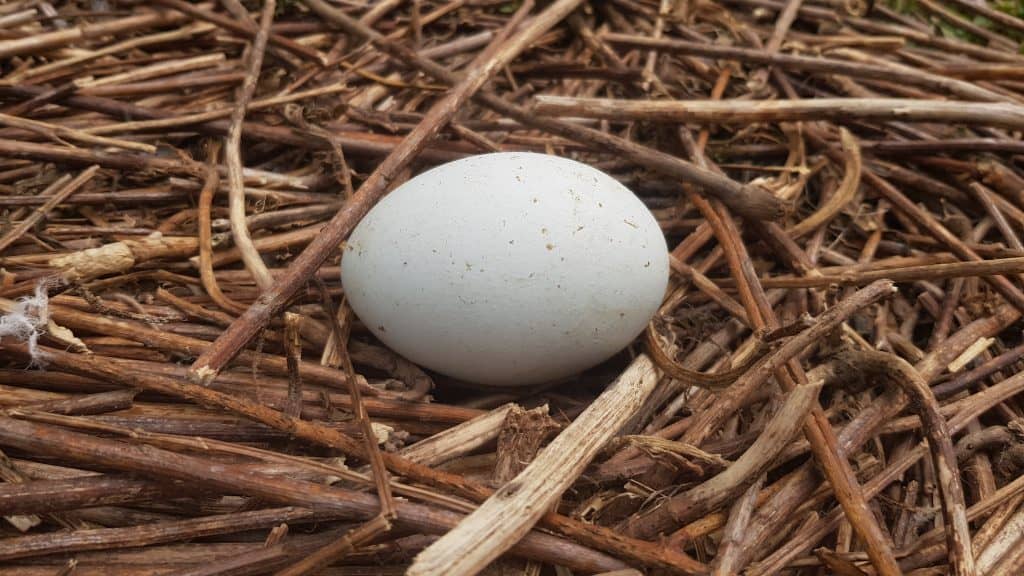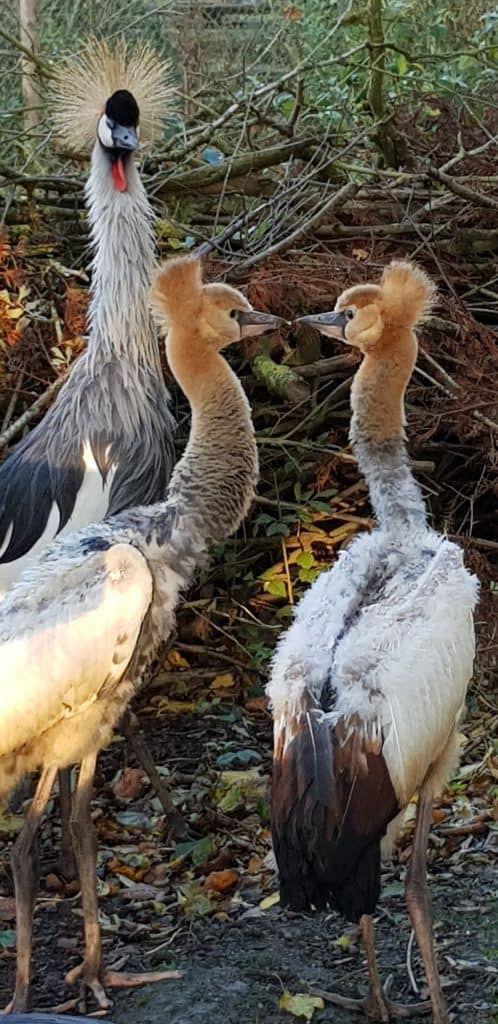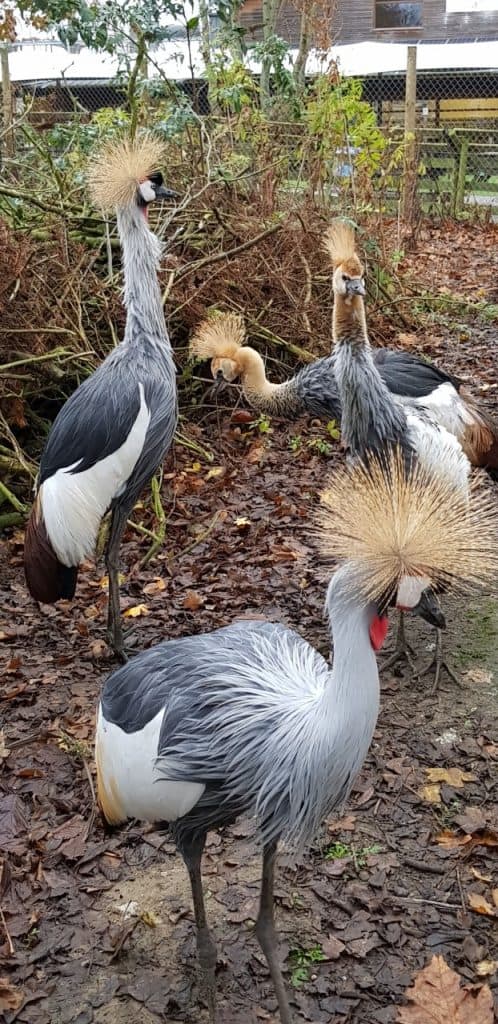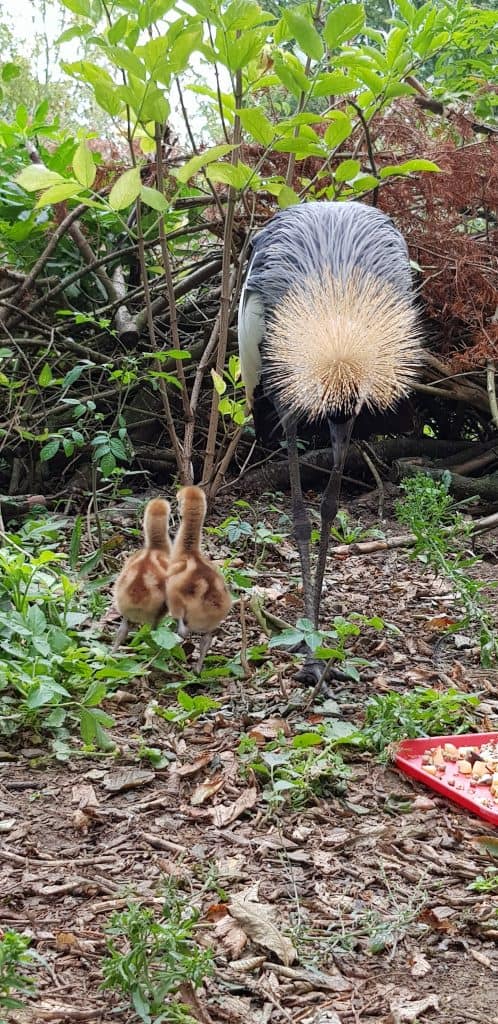If you’ve been following our social media you may have already seen some adorable pictures of the East African Crowned Crane chicks that hatched earlier in the year at our park. If not then don’t despair! In my blog this week I will be reminiscing about these bizarre looking birds.
When you see our Cranes at the park you can see how aptly named they are. Their head has a crown of stiff golden feathers. Impressive birds they stand around 1m high, with an average 3.5kg in weight and have a wingspan of 2m (6.5ft)!
Our male Crane, Boyce is 14 years old (June 2006) and our female, Marlene is 10 years old (June 2010). The average lifespan of this bird in the wild is 22 years but they live considerably longer in captivity. There are Cranes in other Zoos that were born in the 80’s! This year on the 22nd of August they hatched two perfect little chicks… a welcome delight in these difficult times. I’ll come back to these little fluff balls after a quick look at their natural history.

Natural History
African Crowned Cranes (Balearica regulorum) are one of 15 species of Crane worldwide, and also known as Grey Crowned Cranes, African Crested Cranes, Golden Crested Cranes or Golden Crowned Cranes! They look very similar and are closely related to Black Crowned Cranes and the two species have sometimes been treated as the same species in the past. Crowned Cranes are the most ancient of the Cranes, predating their relatives by tens of millions of years.
Like many Crane species they are a wetland specialist and interestingly two subspecies occur. The subspecies that we have at the park, B. r. gibbericeps ranges from the Democratic Republic of the Congo, Rwanda, Kenya, Uganda (where it is the national bird and represented on the country’s flag!) south through Tanzania to Mozambique. The nominate subspecies B. r. regulorum is found from Mozambique south through Zimbabwe to South Africa and west in small numbers to Namibia and Angola.
They aren’t fussy eaters and best described as a generalist. Their diet consists of seed heads, new shoots of grasses, agricultural pulses, nuts, and grain, but they will also hunt insects, frogs, lizards and crabs. They are often associated with grazing herbivores, snatching up prey items disturbed by antelope and gazelle hooves. Although they are not migratory, they are known to make local and seasonal movements depending on the abundance and distribution of food, nest-sites and rainfall.
Unfortunately, in 2012 African Crowned Cranes were uplisted from Vulnerable to Endangered by the IUCN. Their population has declined from over 100,000 individuals in 1985 to 50,000-64,000 individuals in 2004. It is thought that there are now between 17,700 and 22,300 individuals left in the wild.
African Crowned Cranes are threatened by the loss and degradation of their wetland breeding areas from drought and human activities such as overgrazing and drainage/clearing with fires for cultivation. The heavy use of agricultural pesticides is also a big issue as is dam creation for hydroelectric power generation. The species is also threatened by trapping, egg-collecting and hunting. Due to human population pressure, the Cranes are increasingly living in closer proximity to people, exposing them to disturbance and making them more vulnerable to hunting. It is also persecuted in some areas because they can be quite destructive to farmer’s crops. Mortality of birds due to electrocution and collision with overhead power lines is a serious threat in Uganda, South Africa and Tanzania and is likely to increase significantly in the future, across its entire range.
So, you can see now why we were so thrilled to have baby Crowned Cranes here at the park. Responsible captive breeding programmes play an important role in the conservation of this species! It has a been a pleasure watching our pair go through the motions, their courtship is fantastic to see.
Breeding season
The breeding season kicks off with both of the adults performing elaborate courtship displays involving dancing, bowing, and jumping. They also sing together producing a booming call using their gular sac, a bright red inflatable throat sac. I have never been able to film their love song to each other as they recognise me and so come over to investigate if I have some tasty treats. So, there’s a challenge for your next visit to the park!
When it is time to breed, all of a sudden they start to act a bit more secretive and choose a spot amongst some vegetation to build their nest. The nest usually is a circular platform of uprooted grasses and sedges; in the wild they very occasionally nest in trees.

The female will lay between 2 and 5 eggs and then both of the parents will incubate and protect the eggs. These hatch out after 28 to 31 days. It is important at this stage that we leave them to it and we have to be a bit more cautious when working in their enclosure. Breeding Cranes are very protective parents and can get quite aggressive. This year our Cranes had 3 eggs. However, only two hatched out with the remaining egg being infertile which happens occasionally.
The Early Stages
Chicks are precocial, which means they are quite well developed and can run as soon as they hatch. After waiting for the clutch to hatch out the adults then lead the young away from the nest and search for food to feed their new hungry mouths. We then see a new behaviour as the adults do a little Crane-stomp to flush out any invertebrates hiding in the ground. They also actively dig up the soil to ferret out earthworms and other titbits.
The young grow so up so fast! Before long they start to take the shape of the adults, with their legs slowly elongating. Following around after their parents is important for healthy development of their legs.
At two weeks old we start to see the chicks picking up food by themselves! As you can hear in the video they are constantly communicating with the adults. Whilst the Crane family have lots of vegetation in their enclosure to forage for natural food, we also provide a specialised pellet, chopped up bits of meat, fruit and mealworms (which are their absolute favourite!).
One Month Old Already
At one month old the chicks are almost as good as the adults at finding food and their flight feathers start to become more obvious. Both parents are having to work hard now to feed these growing adolescents. As you can see in the photo below by two months old their flight feathers are becoming more adult-like and the crown of feathers on their head are taking shape nicely.

They’re looking big now
Once fully grown they become independent at around 56–100 days. Throughout their development it has been fascinating watching the adults delicately passing the food to the chicks for them to eat. This is something that they still do even once the juveniles are the same size as mum and dad!

Now they look like young adults, and have that teenager look about them. They are even starting to take part in the courtship displays. At this stage in the wild they would soon start to separate from their parents to start their own family. Both males and females look very similar so the best way to tell their gender is via DNA testing. After sending off a feather sample we now know we have two baby boys!
I hope you have enjoyed watching their development and that you now adore Cranes as much as I do! I’ll leave you with this adorable photo of our Crane chick’s bums with their ever-watchful dad.



